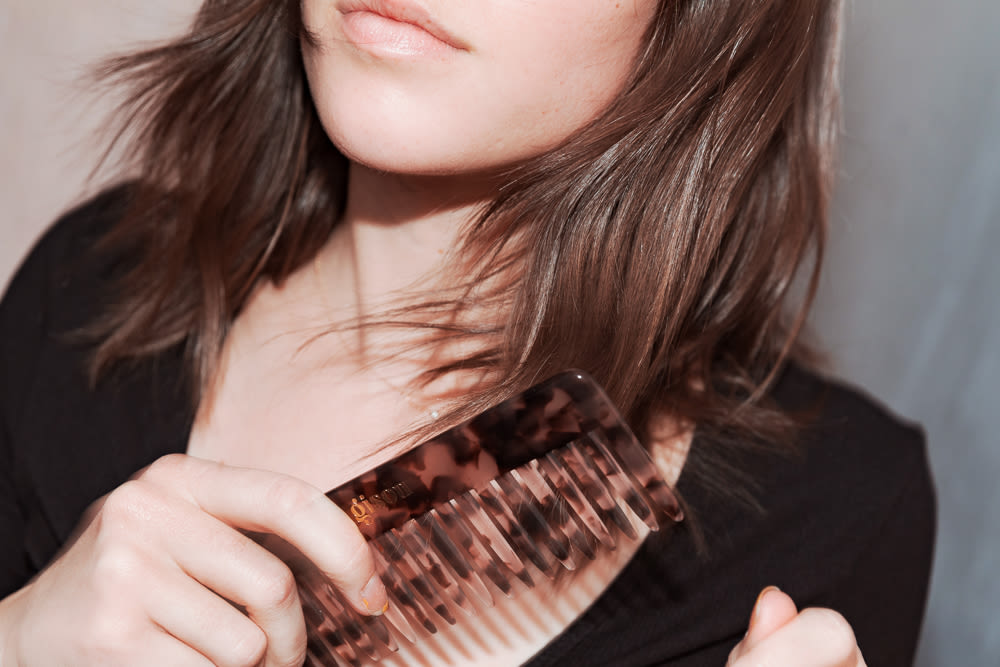Contrary to popular belief, fine hair does not equal thin hair. Just ask Jay Braff, my go-to hair oracle, keeper of my bangs, and friend of Into The Gloss. When my work-in-progress "Beginner's Guide To Fine Haircare" story turned out to be markedly more complicated than it sounded—despite being a fine-haired person myself—I walked across the street to Spoke & Weal for a bang trim and a casual, hour-long chat about fine hair. Jay knows a lot about hair. Lucky for me, he knows even more about fine hair, which he defines as a head of hair in which “the hairs are little; the diameter is smaller.” So yes, he explains, “You can have fine-thick hair, fine-dense hair, and you can have fine-thin hair and everything in between.” Because there is such a broad range of hair types even within the fine category, it can be difficult to definitively talk about how to care for them all. Regardless of where you fall on the spectrum, though, if you’ve got fine hair in any capacity, there are still a handful of general tips you can use to care for that little head of yours. I made a comprehensive list of everything Jay and I came up with that day.
Cleansing
First fact about fine hair: It tends to get greasy easily. This is because, Jay informed me, the shaft of the hair tends to be smoother and less porous than coarser hair types, so the oils sit visibly on top of the hair. That does change depending on the level of texture; fine hair that’s also straight can look greasy hours after washing, while textured fine hair can last a few days between washes. But generally speaking, it can be washed a little more frequently that coarse hair types.
Regardless of how often you wash it, in terms of keeping it healthy, Jay says, “where you shampoo makes a big difference for fine hair.” He recommends shampooing “the top where it’s dirty and not on the bottom where it isn’t.” Then, “condition a little bit on the bottom where it’s thirstier and needs that moisture. Don’t condition on the top—it’ll flatten you out." Your desired outcome will dictate how much of each you use. "If your primary goal is volume, dial back the conditioner, up the shampoo. If your primary goal is not volume and you do like your hair to feel a little softer, it’s OK to use the conditioner.” Basically, “the more conditioner you use, the softer it feels...and the flatter it gets. No way around it—that’s just how it is."
Cutting
Since fine hair is “sensitive to the way that it’s shaped,” you’ve got to be careful—all the details, good and bad, show up in fine hair when you get a trim. But that fact can also be your hair’s greatest strength if it’s done right. Jay recommends two things: First, some level of “soft, subtle layers,” (a good hairstylist should be able to interpret that phrase properly, he tells me) and second, getting it cut dry. But he also notes that the key to getting the cut you want, as opposed to The Rachel (unless that is what you do want—cheers) is proper and full communication with your stylist. “No matter who you go to for a haircut, don’t assume they know what you want based on just a few words…Make sure you give a little background information, give a little history. The more of that exchange that happens, the more likely both parties are going to be successful with the haircut.”
Styling
Once again, styling techniques are going to be based around personal preference. And again, the best way to find out what works for you is by experimenting, which can get messy. But Jay’s number one tip came down to something pretty simple. That is, to use “hold” products—over oil-based products. He explains:
“Regardless of brand, products are going to typically fall one of two categories. There are oil-based products—like hair oil, cream, serum... Fine-haired people are going to more than likely need to stay away from the oil-based stuff. Their hair is going to get weighed down and greasy by those. The other category is what we call hold products. Hair gel, sea salt spray, dry shampoo, mousse, texturizing mist... Hold products typically coat the hair with polymers, so it’s a coating over the hair that doesn’t weigh it down as much as expands the hair. Those products are not going to typically have oils in them. All in all, with finer hair, you want to use less of the greasy stuff and more of the sticky stuff.”
That doesn't mean you can never use oil-based products. In fact, Jay says, when used with a hold product, the two typically "combine on the hair shaft and make it a better version of itself." In my case, the most reliable combination typically is some kind of salt spray plus a tiny bit of Bumble and bumble's Brilliantine on my bangs. The result is a nice, clean-but-piece-y texture that showcases my layers, and it took me a while to get it right. "With a little bit of trial and error," Jay says, "you can find a general combination of things that work well for fine hair." Thanks, Jay!
—Anna Jube
Photographed by Tom Newton.
Got curls? We've got answers.

